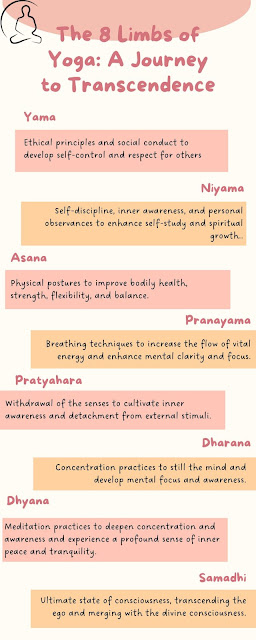The 8 Limbs of Yoga: A Journey to Transcendence
The ancient practice of Yoga has been around for thousands of years and has been proven to be a powerful tool for achieving physical, mental, and spiritual well-being. One of the core tenets of Yoga is the concept of the 8 Limbs, or Ashtanga, which provides a comprehensive framework for individuals to follow on their journey to self-transcendence.
The 8 Limbs of Yoga were first codified by the Indian sage Patanjali in the Yoga Sutras, a text that has become one of the foundational texts of Yoga. The 8 Limbs provide a roadmap for individuals seeking to achieve the ultimate goal of Yoga, which is to transcend the limitations of the ego and merge with the universal consciousness.
In this article, we will explore each of the 8 Limbs in detail and discuss how they can help individuals on their journey to self-transcendence.
The 8 Limbs of Yoga
1. Yama: Ethical principles
The first limb of Yoga is Yama, which refers to ethical principles or restraints. Yama consists of five ethical principles: Ahimsa (non-violence), Satya (truthfulness), Asteya (non-stealing), Brahmacharya (celibacy or moderation), and Aparigraha (non-attachment).
By practicing these ethical principles, individuals can cultivate a sense of moral integrity, which is essential for developing a deeper connection with oneself and the universe.
2. Niyama: Self-discipline and spiritual observances
The second limb of Yoga is Niyama, which refers to self-discipline and spiritual observances. Niyama consists of five practices: Saucha (cleanliness), Santosha (contentment), Tapas (discipline), Svadhyaya (self-study), and Ishvara Pranidhana (surrender to a higher power).
By practicing these observances, individuals can develop a deeper understanding of their own nature and cultivate a sense of inner peace and contentment.
3. Asana: Physical postures
The third limb of Yoga is Asana, which refers to physical postures. Asana consists of various poses that are designed to promote physical strength, flexibility, and balance.
By practicing Asana, individuals can improve their physical health and well-being, which is essential for achieving a deeper connection with the universe.
4. Pranayama: Breath control
The fourth limb of Yoga is Pranayama, which refers to breath control. Pranayama consists of various breathing techniques that are designed to promote relaxation and improve the flow of prana, or life force energy, throughout the body.
By practicing Pranayama, individuals can improve their respiratory health and promote a sense of inner peace and relaxation.
5. Pratyahara: Withdrawal of the senses
The fifth limb of Yoga is Pratyahara, which refers to the withdrawal of the senses. Pratyahara involves turning inward and tuning out external distractions in order to focus on the inner self.
By practicing Pratyahara, individuals can cultivate a deeper sense of introspection and develop a greater understanding of their own nature.
6. Dharana: Concentration
The sixth limb of Yoga is Dharana, which refers to concentration. Dharana involves focusing the mind on a single object, such as a mantra or a candle flame, in order to cultivate a sense of mental clarity and focus.
By practicing Dharana, individuals can improve their ability to concentrate and develop a greater sense of mental clarity and focus.
7. Dhyana: Meditation
The seventh limb of Yoga is Dhyana, which refers to meditation. Dhyana involves entering into a state of deep relaxation and inner stillness in order to connect with the universal consciousness.
By practicing Dhyana, individuals can cultivate a sense of inner peace and develop a deeper connection with the universe. Regular meditation can also help individuals to manage stress and improve their overall mental and emotional well-being.
8. Samadhi: Self-realization
The final limb of Yoga is Samadhi, which refers to self-realization. Samadhi is the ultimate goal of Yoga and involves transcending the limitations of the ego and merging with the universal consciousness.
The 8 Limbs of Yoga: A Journey to Transcendence" is a comprehensive guide to yoga practice, covering the ancient philosophy of Ashtanga Yoga. It provides insight into the eight limbs of yoga, including asanas (postures), pranayama (breathing), and meditation, as well as practical tips for integrating these practices into daily life. This book is an excellent resource for those seeking to deepen their understanding of yoga, and it is a valuable addition to any yoga programs.





Comments
Post a Comment